
Placodermi is a class of armoured prehistoric fish, known from fossils, which lived from the Silurian to the end of the Devonian period. Their head and thorax were covered by articulated armoured plates and the rest of the body was scaled or naked, depending on the species. Placoderms were among the first jawed fish; their jaws likely evolved from the first of their gill arches.

Dunkleosteus is an extinct genus of large arthrodire ("jointed-neck") fish that existed during the Late Devonian period, about 382–358 million years ago. It was a pelagic fish inhabiting open waters, and one of the first apex predators of any ecosystem.

Arthrodira is an order of extinct armored, jawed fishes of the class Placodermi that flourished in the Devonian period before their sudden extinction, surviving for about 50 million years and penetrating most marine ecological niches. Arthrodires were the largest and most diverse of all groups of placoderms.

Brindabellaspis stensioi is a placoderm with a flat, platypus-like snout from the Early Devonian of the Taemas-Wee Jasper reef in Australia. When it was first discovered in 1980, it was originally regarded as a Weejasperaspid acanthothoracid due to anatomical similarities with the other species found at the reef.
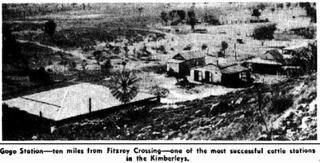
The Gogo Formation in the Kimberley region of Western Australia is a Lagerstätte that exhibits exceptional preservation of a Devonian reef community. The formation is named after Gogo Station, a cattle station where outcrops appear and fossils are often collected from, as is nearby Fossil Downs Station.

Dicksonosteus is an extinct genus of basal arthrodire placoderm fish which lived during the Early Devonian period of Spitsbergen, Norway.
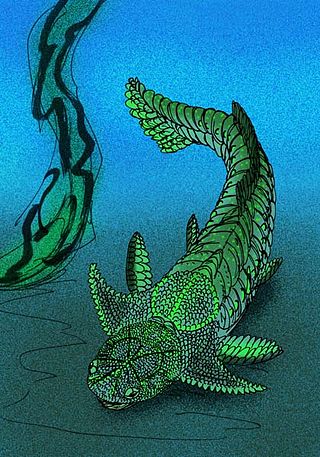
Actinolepidae is an extinct family of placoderm fishes which lived during the Early Devonian period. They are considered to be among the most primitive of the arthrodires, and are widely accepted to be phylogenetically basal to the group.

Incisoscutum is an extinct genus of arthrodire placoderm from the Early Frasnian Gogo Reef, from Late Devonian Australia. The genus contains two species I. ritchiei, named after Alex Ritchie, a palaeoichthyologist and senior fellow of the Australian Museum, and I. sarahae, named after Sarah Long, daughter of its discoverer and describer, John A. Long.

Mcnamaraspis is an extinct monospecific genus of arthrodire placoderm that inhabited the ancient reef system of north Western Australia during the Frasnian epoch of the Late Devonian period. The type specimen was found and described by John A. Long from the Gogo Formation near Fitzroy Crossing. This fossil fish showed new anatomical features in arthrodires, like the well-preserved annular (ring-shaped) cartilages of the snout, previously inferred to be present by Erik Stensiö of Sweden. It is occasionally referred to as "The Gogo Fish" after the locale the holotype was excavated from.

Fallacosteus is an extinct monospecific genus of arthrodire placoderm from the Early Frasnian stage of the Late Devonian period, found at the Gogo Formation of Kimberley, Western Australia. As with almost all other camuropiscids, F. turneri had an elongated snout that may have enhanced its hydrodynamic streamlining.
Erromenosteus is a genus of extinct, medium-sized brachythoracid arthrodire placoderm from the Late Frasnian of the Kellwasserkalk facies of Late Devonian Bad Wildungen and Bicken, Germany.
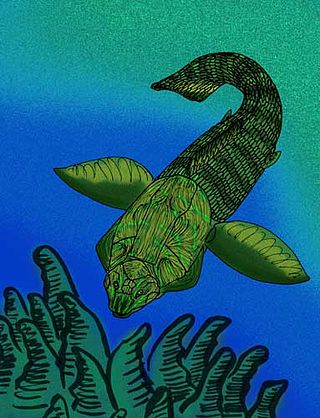
Holonematidae is an extinct family of relatively large arthrodire placoderms from the Early to Late Devonian. Almost all fossil specimens are of armor fragments, though, all have distinctive ornamentation, often of unique arrangements and patterns of tubercles, that are diagnostic of the family. The trunkshield is very elongated, giving the armor an overall "barrel" like appearance.
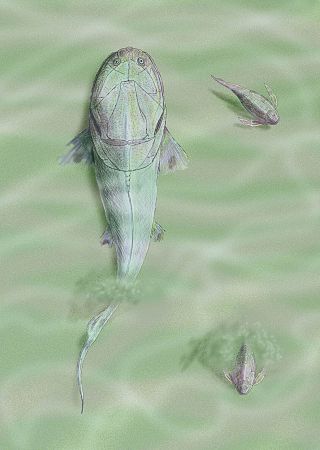
Homostiidae is a family of flattened arthrodire placoderms from the Early to Middle Devonian. Fossils appear in various strata in Europe, Russia, Morocco, Australia, Canada and Greenland.

Errolosteus goodradigbeensis is an extinct buchanosteid arthrodire placoderm. Its fossils have been found in Emsian-aged marine strata of New South Wales, Australia.

Goodradigbeeon is an extinct genus of buchanosteid arthrodire placoderm. Its fossils have been found in Emsian-aged marine strata from the Taemas-Wee Jasper reef of New South Wales, Australia and the type species is G. australianum.
Anarthraspis is an extinct genus of arthrodire placoderm fishes which lived during the Early Devonian period. It contains two species described in 1932, Anarthraspis chamberlini and Anarthraspis montanus, both found in the Beartooth Butte Formation of Wyoming and Montana, USA, and assigned to the genus in 1934.
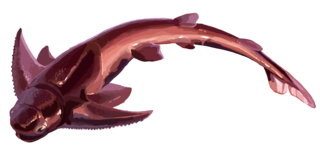
Kujdanowiaspis is an extinct genus of arthrodire placoderm fish from the Early Devonian of Podolia (Ukraine), Poland and Spain. Kujdanowiaspis is known from many fragmentary head shields and body armours.

Millerosteus is an extinct genus of coccosteid arthrodire placoderm from the Early Givetian stage of the Middle Devonian period. Fossils are found in the Orkneys and Caithness, Scotland. It was a small placoderm with an body length of 14 cm (5.5 in). Millerosteus is one of the few arthrodires known from specimens preserving the entire skeleton.
Dhanguura is an extinct genus of arthrodire from the Early Devonian of Wee Jasper, NSW. It contains the single species D. johnstoni.

Bryantolepis is an extinct genus of arthrodire placoderm fish from the Early Devonian period found in northern USA, and currently consists of two species, Bryantolepis brachycephala and Bryantolepis williamsi. The genus is known from multiple parts of the skull roof, the suborbital, endocranium, and trunk shield.
























